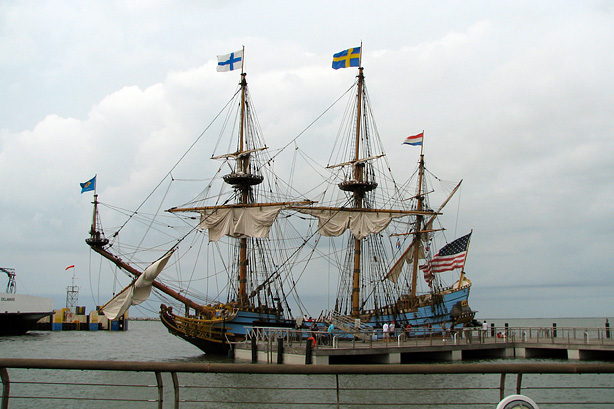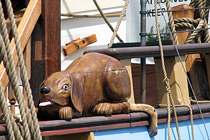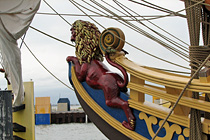
The Kalmar Nyckel at dock in Lewes, Del. Each of the numerous lines in the rigging has its own name, and Captain Lauren Morgens '02 knows them all. Photo by Linda Glaser.
Tall ship sailing is ongoing research project for Captain Lauren Morgens

Captain Lauren Morgens '02 guides volunteers as they set the main sail. Photo by Linda Glaser.
Captain Lauren Morgens '02 stands on the quarterdeck surveying her ship, red sash around her waist and a tall feather in her pirate hat. It is a cloudy August afternoon in Lewes, Del.; her crew has finished scrubbing the Kalmar Nyckel's deck, and the last sailor has come off the rigging. Once the tall ship clears the shallows, Morgens' command to "set the mizzen" rings across the ship in a sing-song cadence that seems as old as the sea itself.
The pirate-garbed crew leaps to obey, hauling line to lower the mizzen sail, one of eight on this re-creation of the square-sailed ship that brought colonists from Sweden to the New World in 1638. Now it carries tourists on short educational jaunts from ports along the East Coast.

While the original records of the Kalmar Nyckel were lost, the carvings on the ship are replicas from another ship of the same time period. This watchdog has its outside eye open to watch for trouble. Photo by Linda Glaser.
Even when the second mate takes the con, Morgens never stops scanning the ship that she's captained since 2006. When one of the trainee crew flubs a belay, she's down the ladder and across the deck in the blink of an eye. But the crewman receives nothing worse than a gentle scold, and it's clear these sailors appreciate their captain, since they vote with their feet: Except for the officers, the crew is entirely volunteer.
With so much wind, Morgens orders all the lower sails set, with their complicated rigging. "I've sailed on a lot of tall ships," she says, "but one of the reasons I've stayed with the Kalmar Nyckel is its sheer complexity. There's no manual; all we have are a couple of paintings and some sketchy descriptions. We had to figure out how to sail it, and that's been fun as a mental puzzle."
Morgens was ready for the challenge, having started sailing dinghies when she was 8 years old; she later taught Laser sailing at Cornell. But a whole new world was opened to her during her sophomore year when she studied oceanography, nautical science and maritime studies aboard a brigantine through the Cornell SEA Semester program.

Captain Morgens on the quarterdeck, calling commands to her crew as they lower the sails. Photo by Linda Glaser.
The brigantine is a complex ship that requires many people -- a community -- to sail, and Morgens was hooked. She switched her major from biology to anthropology and wrote papers on such topics as Pacific sailing cultures and traditional navigation.
The Kalmar Nyckel is primarily a maritime educational vessel, a good match for Morgens' quick mind; she enjoys research projects that let her explore the ship's abilities. Her passion for learning is shared by her husband, Matt Sarver '02, who serves as a volunteer "deck chief" when he's not occupied with his consulting firm, Sarver Ecological.
Though both studied biology at Cornell at the same time, the two didn't meet until 2004, on a five-month expedition with the Cornell Lab of Ornithology searching for the ivory-billed woodpecker. Committed birders (Morgens notes that her father, Ned Morgens '63, an emeritus member of the Cornell Board of Trustees, has been on the Lab of Ornithology board since before she was born), the couple have continued to contribute to ornithology research on two recent trips to Colombia, capturing audio recordings of several newly described bird species for the lab's Macaulay Library.

Captain Lauren Morgens and her husband Matt Sarver. The couple met in 2004 on a five-month expedition with the Cornell Lab of Ornithology searching for the ivory-billed woodpecker. Photo by Linda Glaser.
The challenge of sailing a complex ship hits home as the ship approaches the dock: despite the helmsman keeping the ship hard to starboard and the captain's maneuvering, the Kalmar Nyckel keeps turning to port. She's a ship with a mind of her own, and there's no wind or tide to explain her recalcitrance. Except, perhaps, that she shares the feeling that this 2.5-hour trip was much too short.
On the third try, Morgens convinces the ship to properly approach, and Sarver leaps onto a piling and then to the dock, where he rushes to secure the lines. As the passengers cross the gangway, Morgens hands out ship maps as souvenirs, keeping one eye on the sky. If the gathering clouds unleash their fury again, she'll cancel the evening sail. Though the Kalmar Nyckel was built to cross the ocean, safety comes first for this captain, as does the comfort of her crew and passengers.

The original Kalymar Nyckel was armed with cannons, and carried soldiers to repel boarders. The carved lion on the bow, larger than a man, designated the armed merchant ship as a Swedish warship. The recreated Kalymar Nyckel also carries guns capable of being fired. Photo by Linda Glaser.
But underneath her professionalism lurks a spirit of adventure. Morgens tells of the day she sailed 185 miles in 24 hours, with a midwatch speed averaging 9.5 knots. "That was a huge day," she says, her smile wide. "It's really cool to stretch your legs and see what you can do."
Linda B. Glaser is staff writer for the College of Arts and Sciences.
Links: